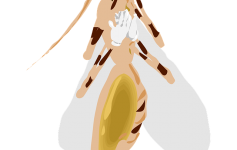There’s
a mix of emotions that occur during this time. Many of my clients and friends
describe their feelings as similar to a roller-coaster ride between excitement,
stress, anticipation, and sadness or grief.1 For those missing loved
ones, dealing with a breakup, or feeling a loss, holidays can be especially
trying. If this is a situation you are in, this
article may be of help
One
thing that can relieve some of the typical holiday jitters is preparation. I’ve
discussed several
tips in the past on how to make sure you’re getting the most out of your
holidays and staying healthy, happy, while taking good care of yourself (and
your belly).
For
me, I’ve been busy referencing my upcoming book as visions of “holiday shopping”
left undone dances in my head. Thankfully, I have aromatherapy to help me. In
fact, I just released an
excerpt from BreakFree Medicine
on valerian essential oil! In it, I review why it may be a calming essential
oil and assist your little ones to dream happily of visions of healthy treats
in their heads. One of my favorite studies demonstrated that a combination of
valerian and lemon balm oil improved restlessness and increased concentration
in primary school children. You can read more about valerian and get a peek inside my book here.
I
also just totally geeked out on the science behind the oils of frankincense,
gold, and myrrh on my homepage, in celebration of the Christmas season. Learn
more here.
Now,
besides the holiday tips mentioned and calming our brain and supporting our
immune system with essential oils, I thought I’d leave you with another “spirit
of the season” thought to ponder. It’s one of the best studies of the year, right
up there with my nerd-fests on the microbiome, the biochemistry of gloomy toxic
exposure, and essential oils. It’s the study that proves that the Christmas Spirit
is a biochemical phenomenon found in our brain. The article was released mid-December
in the British Medical Journal. It
was a small trial with twenty people and compared functional imaging of the
brain between people who lived in the same area. Half of them had Christmas
traditions and the other half did not. The researchers wanted to determine if
brain activation was unique to those with past memories of Christmas events. They
concluded that, “There is a “Christmas
spirit network” in the human brain comprising several cortical areas.” Here’s
the excerpt:
Main outcome measures Brain activation unique to the group with Christmas
traditions during visual stimulation with images with a Christmas theme.
Methods Functional brain scans optimised for detection of the
blood oxygen level dependent (BOLD) response were performed while participants
viewed a series of images with Christmas themes interleaved with neutral images
having similar characteristics but containing nothing that symbolises
Christmas. After scanning, participants answered a questionnaire about their
Christmas traditions and the associations they have with Christmas. Brain
activation maps from scanning were analysed for Christmas related activation in
the “Christmas” and “non-Christmas” groups individually. Subsequently,
differences between the two groups were calculated to determine Christmas
specific brain activation.
Results Significant clusters of increased BOLD activation in
the sensory motor cortex, the premotor and primary motor cortex, and the
parietal lobule (inferior and superior) were found in scans of people who
celebrate Christmas with positive associations compared with scans in a group
having no Christmas traditions and neutral associations. These cerebral areas
have been associated with spirituality, somatic senses, and recognition of
facial emotion among many other functions.
Conclusions There is a “Christmas spirit network” in the human
brain comprising several cortical areas. This network had a significantly
higher activation in a people who celebrate Christmas with positive
associations as opposed to a people who have no Christmas traditions and
neutral associations. Further research is necessary to understand this and
other potential holiday circuits in the brain. Although merry and intriguing,
these findings should be interpreted with caution.
So,
here’s another holiday tip. If you don’t have positive or any holiday
traditions, your brain literally may not be as stimulated or “as joyful” as those
who do have them. Therefore, to turn Scrooge thoughts into kind ones, consider
making fun holiday traditions to literally “put you in the spirit.”
I
am grateful to all my readers here and appreciate all you have taught me with
your comments and questions this year and always! Wishing you a happy, healthy,
and abundant holiday season.
References:
Carr
D, Sonnega J, Nesse RM, House JS. Do Special Occasions Trigger Psychological
Distress Among Older Bereaved Spouses? An Empirical Assessment of Clinical
Wisdom. The Journals of Gerontology Series B: Psychological Sciences and
Social Sciences. 2014;69B(1):113-122. doi:10.1093/geronb/gbt061.
Evidence of a Christmas spirit network in the
brain: functional MRI study. BMJ. 2015;351:h6266.

